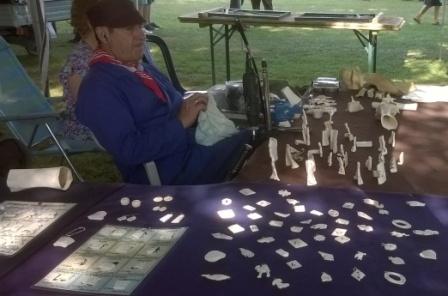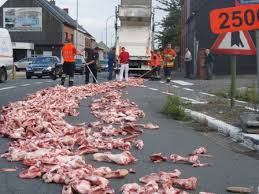Carcasses and entrails are cleaned up by all sorts of scavengers in nature. One death is another man's bread. Or death gives life. Not only exotic vultures, but crows, ravens and wild pigs, dogs, rats, cats, martens, foxes, catfish, eel, and masses of insects have feed on carcasses.
There’s not many waste. Our grandparents could use everything.
If you used intestines to make sausages (or strings...), the contents of the intestines can be put on the fertilizer or compost heap. Hooves can be boiled to make glue. Legs are crushed by the dog or pig and eaten. Then there is almost not much left.
 Skulls I once saved, because I liked them. You can get the last bits of meat off by burying (but then they turn yellow - brown) in the compost heap or to expose them near an anthill.
Skulls I once saved, because I liked them. You can get the last bits of meat off by burying (but then they turn yellow - brown) in the compost heap or to expose them near an anthill.
Large bones I did (after boiling off, possibly marrow out of it) in the stove. Some are useful as handles for tools.
Intestines are seldom used. Along with the plumage of fowls that will usually remain as waste. I've often buried it in the middle of a well-functioning compost pile. The feathers need 2 years to digest completely.
We used to use the remaining intestines of poultry as pig feed. Pigs (like humans) are omnivores. The remains of intestines of mammals went to the chickens and turkeys, also avid omnivores. (Thus, never from poultry to poultry, or from mammal to mammal, in order to avoid transfer of parasites as much as possible).
Fermenting into biogas is also possible in principle.
Previously carcasses of diseased or dead animals were buried in a sufficiently deep pit on a distant spot and sprinkled with lime so to avoid spread of germs.
“Companion animals” lighter than 10 kilo may still be buried deep enough (at least 50 cm below ground), and no non - biodegradable packaging (not a plastic bag). It may only in sandy soil where it can break, not in (closure, dense) clay. Refer to the police of the municipality first. Some municipalities have a collection (solid waste center), or a pet cemetery, or an animal crematorium.
In Belgium only Rendac may collect and treat (rendering plant: skinning behind closed doors ; cattle rendering plant) waste and carcasses.
 On an industrial scale, animal waste was used to make fertilizer, animal food and soap. That changed after the peak of BSE or mad cow disease in 1992. Bovine Spongiform Encephalopathy or spongy brain disease in cattle is a fatal deterioration by ponging brains. The cause is still unclear. There are suspicions that it may involve pesticides or spontaneous mutations, later spread through bone meal in animal feed.
On an industrial scale, animal waste was used to make fertilizer, animal food and soap. That changed after the peak of BSE or mad cow disease in 1992. Bovine Spongiform Encephalopathy or spongy brain disease in cattle is a fatal deterioration by ponging brains. The cause is still unclear. There are suspicions that it may involve pesticides or spontaneous mutations, later spread through bone meal in animal feed.
The disease is similar and / or related to the incurable Creutzfeldt -Jakob disease (CJD), akin to the original form of it: the sheep disease scrapie. The processing of animal carcasses and waste is therefore strictly regulated in Europe. Infected animals are burned.
The BSE agent, called a prion, is destroyed not by any method of preparation in the home kitchen. The prion exists especially in brains and marrow.
Cadaver: Someone who is too young to be president. (Tom Lanoye)
